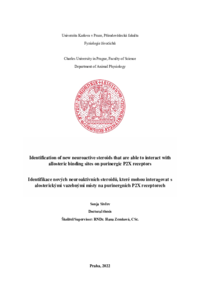Identification of new neuroactive steroids that are able to interact with allosteric binding sites on purinergic P2X receptors
Identifikace nových neuroaktivních steroidů, které mohou interagovat s alosterickými vazebnými místy na purinergních P2X receptorech
dizertační práce (OBHÁJENO)

Zobrazit/
Trvalý odkaz
http://hdl.handle.net/20.500.11956/177142Identifikátory
SIS: 183993
Kolekce
- Kvalifikační práce [21484]
Autor
Vedoucí práce
Oponent práce
Vyklický, Vojtěch
Stojilkovic, Stanko S.
Fakulta / součást
Přírodovědecká fakulta
Obor
Fyziologie živočichů
Katedra / ústav / klinika
Katedra fyziologie
Datum obhajoby
16. 9. 2022
Nakladatel
Univerzita Karlova, Přírodovědecká fakultaJazyk
Angličtina
Známka
Prospěl/a
Klíčová slova (česky)
Purinergní signalizace, adenohypofýza, purinergní P2X receptory, iontové kanály, extracelulární ATP, alosterické modulátory, ivermektin, neurosteroidy, primární buněčná kultura, sekrece hormonů, HEK293 buňky, patch clampKlíčová slova (anglicky)
Purinergic signaling;anterior pituitary, purinergic P2X receptors, ion channels, extracellular ATP, allosteric modulators, ivermectin, neurosteroids, primary cell culture, hormone secretion, HEK293 cells, patch clamp(CZ) Purinergní P2X receptory jsou ATP-aktivavané iontové kanály, které mají mnoho fyziologických rolí a nově představují důležité terapeutické cíle v řadě nemocí. P2X podjednotky se skládají ze dvou transmembránových α-helixů (TM1 a TM2), extracelulární ATP-vazebné domény a intracelulárních N- a C- konců. Sedm různých P2X podjednotek (P2X1-7) se může složit a vytvořit homotrimérní nebo heterotrimérní iontové kanály propustné pro monovalentní kationty a vápník. P2X receptory se vyskytují prakticky ve všech tkáních, v mozku mají největší zastoupení podjednotky P2X2, P2X4 a P2X7. Aktivita P2X nezávisí jen na přítomnosti ATP, ale také alosterických modulátorů, které mohou inhibovat nebo zvyšovat aktivitu těchto kanálů. Našim cílem bylo identifikovat nové molekuly, které mohou interagovat s alosterickými vazebnými místy na P2X receptorech, navrhnout a syntetizovat nové analogy neurosteroidů a určit kritické receptorové domény nebo aminokyseliny, které jsou důležité pro vazbu neurosteroidu. Pomocí patch-clamp elektrofyziologické techniky jsme snímali ATP- evokované proudy z HEK293T buněk transfekovaných potkaními P2X2, P2X4 a P2X7, a z buněk předního laloku hypofýzy nebo hypotalamických neuronů, které tyto receptory přirozeně exprimují. Nalezli jsme, že 17β-ester deriváty testosteronu, především...
(EN) Purinergic P2X receptors are ATP-gated cation channels with multiple physiological roles and are emerging as important therapeutic targets in a range of diseases. P2X subunit consists of two transmembrane helices (TM1 and TM2), an extracellular ATP-binding domain, and intracellular N- and C- termini. Seven different P2X subunits (P2X1-7) can assemble to form homotrimeric or heterotrimeric ion channels permeable for monovalent cations and calcium. P2X are ubiquitously expressed. Among them, P2X2, P2X4, and P2X7 are the most abundant within the brain. The activity of P2X depends not only on the presence of ATP but also on allosteric modulators that may inhibit or potentiate the activity of these channels. Our aim was to identify new molecules that could interact with allosteric binding sites on P2X receptors, design and synthesize new analogues of neurosteroids, and define crucial receptor domains and amino acids important for neurosteroid binding. By using a patch-clamp electrophysiology technique we recorded ATP-induced currents in HEK293T cells transfected with rat P2X2, P2X4, and P2X7, as well as in the rat anterior pituitary cells and hypothalamic neurons endogenously expressing these receptors. We found that 17β-ester derivatives of testosterone, namely testosterone butyrate and...
